England, famous for its rolling hills, quaint villages and historic landmarks, is home to a network of rivers that meander through its picturesque countryside. While many of these rivers invite you to go on leisurely walks, fishing and picnicking, some have remarkably cold waters. These rivers may not be the typical destinations for summer swims, but they still have their own unique allure. In this article, we will venture into the heart of England to discover the ten coldest rivers that flow through its peaceful quiet hills.
The Factors Behind Cold Rivers
The temperature of a river is influenced by a combination of natural and environmental factors, each of which can have a significant impact on the water’s temperature. Understanding these influences is essential to understand why some rivers are colder than others and how they maintain their temperature. Here are the key factors that influence the temperature of a river:
Altitude
Rivers that flow through high-altitude regions tend to have colder water. This is primarily because as water travels downhill from mountains or highlands, it can become colder due to cold air temperatures in the surrounding environment. Rivers originating from snow-fed mountain ranges or glaciers, for example, are often quite cold and remain cold if they travel in higher altitudes.
Source Type
The source of a river is a crucial factor. Rivers that begin as springs or glacier meltwater sources are typically much colder than those originating from lakes or smaller tributaries. Spring-fed rivers, in particular, maintain a consistent, chilly temperature as they emerge from underground sources.
Shade and Vegetation
The presence of vegetation, especially dense tree cover along a river’s banks, can shield the water from direct sunlight. Shade helps to keep the water temperature lower, as it prevents the sun’s heat from warming the river’s surface. This is why rivers flowing through heavily forested areas may have colder water.
Groundwater Input
Rivers that receive a significant amount of groundwater input tend to have more stable and cooler temperatures. Groundwater maintains a relatively consistent temperature throughout the year, so rivers fed by springs or influenced by groundwater sources often have a constant supply of cooler water.
Climate and Weather
Local climate and weather conditions also play a substantial role in river temperature. Areas that experience frequent rainfall and cloud cover may have cooler rivers because these conditions can limit the amount of direct sunlight that reaches the water’s surface.
Seasonal Variation
River temperatures can also vary significantly with the seasons. In colder climates, rivers may freeze over in the winter. Snowmelt from the surrounding watershed can also impact river temperatures in the spring, causing temporary cold spells.
Human Activities
Sadly, human activities can influence river temperatures. Urbanization, deforestation, and industrial discharges can raise water temperatures due to heat absorption and reduced shade. Conversely, the removal of trees and vegetation from riverbanks can allow more sunlight to reach the water, potentially warming it.
River Depth and Flow Rate
Deeper and faster-flowing rivers tend to have more stable and cooler temperatures. Deeper rivers have a larger volume of water, which due to the specific heat capacity of water, can resist temperature changes. Faster flow rates promote mixing with cooler groundwater sources and also make sure water doesn’t stay in one place long enough to heat up.
Geographic Location
The geographic location of a river within a region or country can also influence its temperature. Rivers near coastlines may be influenced by sea temperatures, while those in more remote inland areas can be influenced by local climate patterns.
Climate Change
Finally, climate change can have long-term effects on river temperatures. Rising global temperatures can lead to warmer river water, which can have consequences for aquatic ecosystems, including shifts in the distribution of fish species and potential impacts on water quality.
Understanding these factors is crucial. This is because river temperature plays a vital role in the health and sustainability of aquatic life, making it an essential aspect of river management and conservation efforts. Thus, these dynamics are not only important for appreciating the natural dynamics of rivers but also for managing and conserving their precious ecosystems.
The Ten Coldest Rivers in England
We will now explore the ten coldest rivers in England, along with some insights into their unique characteristics, ecological importance, and recreational opportunities they may have for any adventurers.
1. River Eden, Cumbria
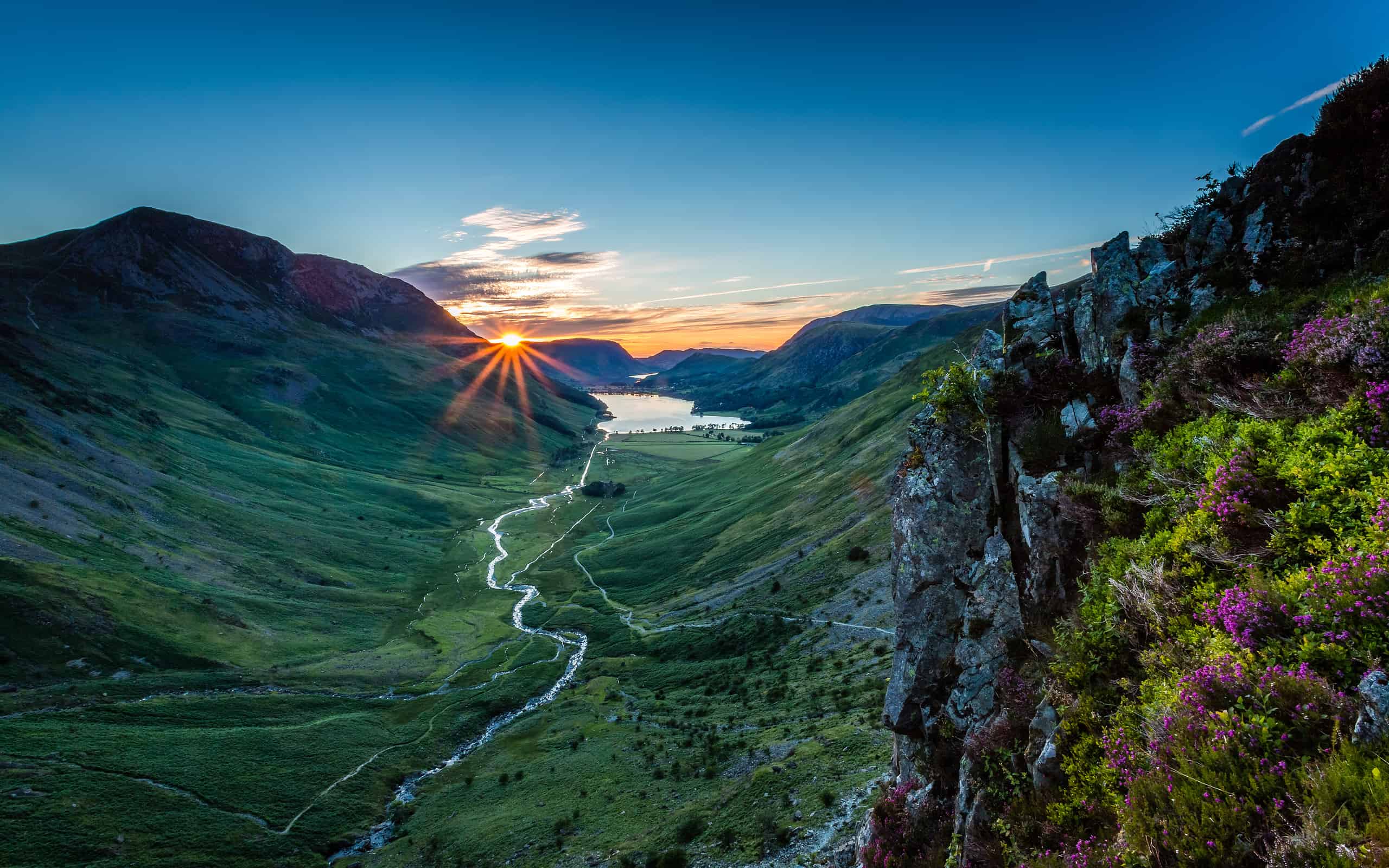
Sunset over Buttermere, The Lake District, Cumbria, England
©Michael_Conrad/iStock via Getty Images
Temperature: The River Eden in Cumbria is known for its icy waters, with temperatures often ranging from 5°C to 10°C (41°F to 50°F).
Ecological Significance: This cold river is not only a testament to the region’s natural beauty but is also a critical habitat for various aquatic species. The Eden is home to thriving populations of salmon and trout, particularly the iconic Atlantic salmon, which uses the river for spawning. The presence of these fish indicates the high water quality of the river.
Recreational Activities: The River Eden is attractive to anglers from near and far, since it is a hotspot for fly fishing. The challenging currents as well as the attraction of catching salmon and trout in freshwaters draw fishers from all over. Additionally, the river’s picturesque surroundings create opportunities for scenic walks and birdwatching.
2. River Ure, Yorkshire Dales
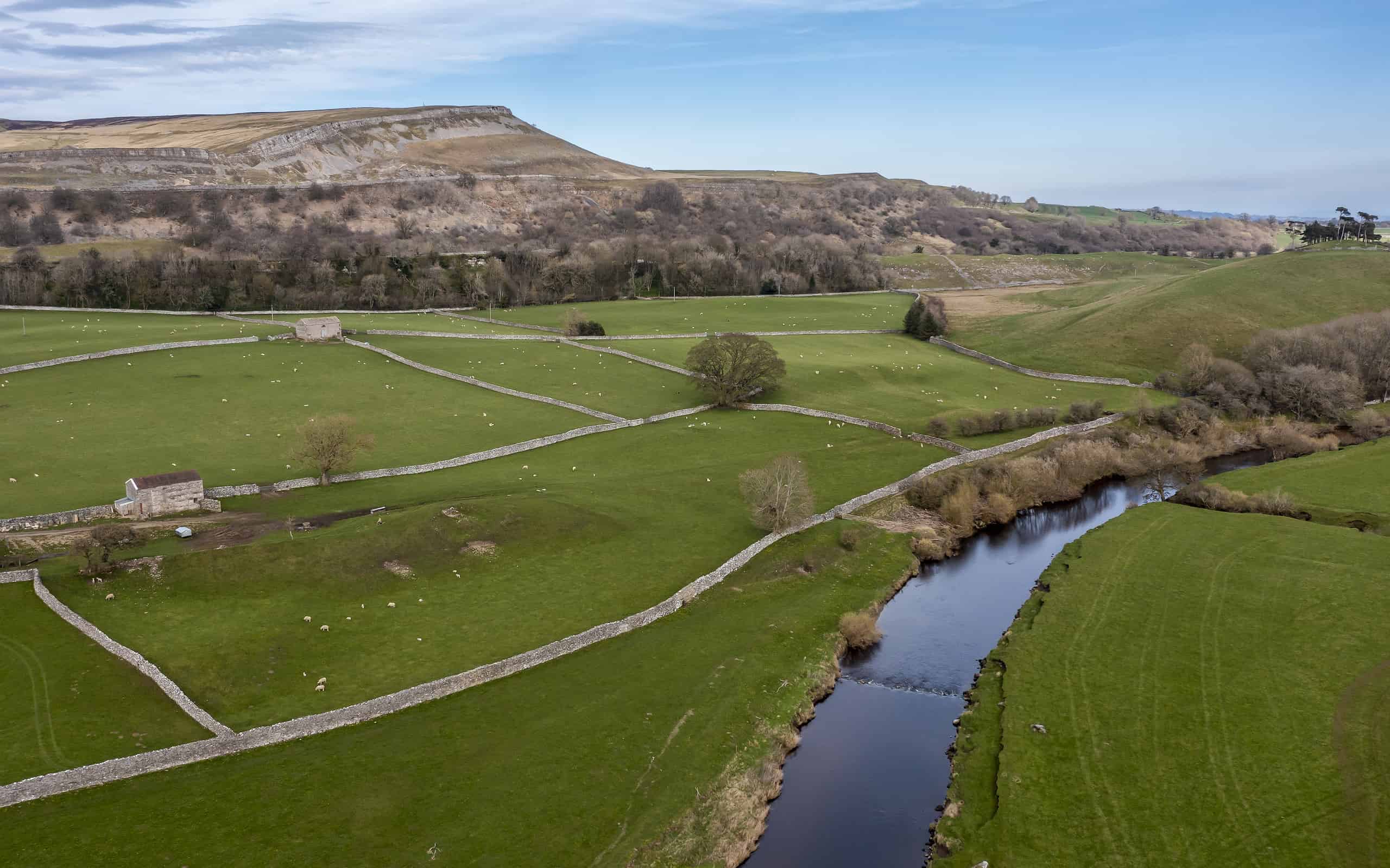
elevated panoramic view looking east of the river ure and ivy scar at thornton rust in the yorkshire dales summer day no people
©GrahamMoore999/iStock via Getty Images
Temperature: Flowing through the rugged Yorkshire Dales, the River Ure maintains temperatures of around 5°C to 11°C (41°F to 52°F).
Ecological Significance: The Ure is not just a cold river. It is also a vital ecosystem for native fish species like grayling. Additionally, the river serves as a habitat for a variety of aquatic invertebrates, which contribute to its ecological richness.
Recreational Activities: Anglers come to the River Ure to try their hand at catching brown trout and grayling. Fly fishing is a popular pastime here. The river also has scenic landscapes that provide opportunities for hiking and exploring the Yorkshire Dales National Park.
3. River Swale, North Yorkshire
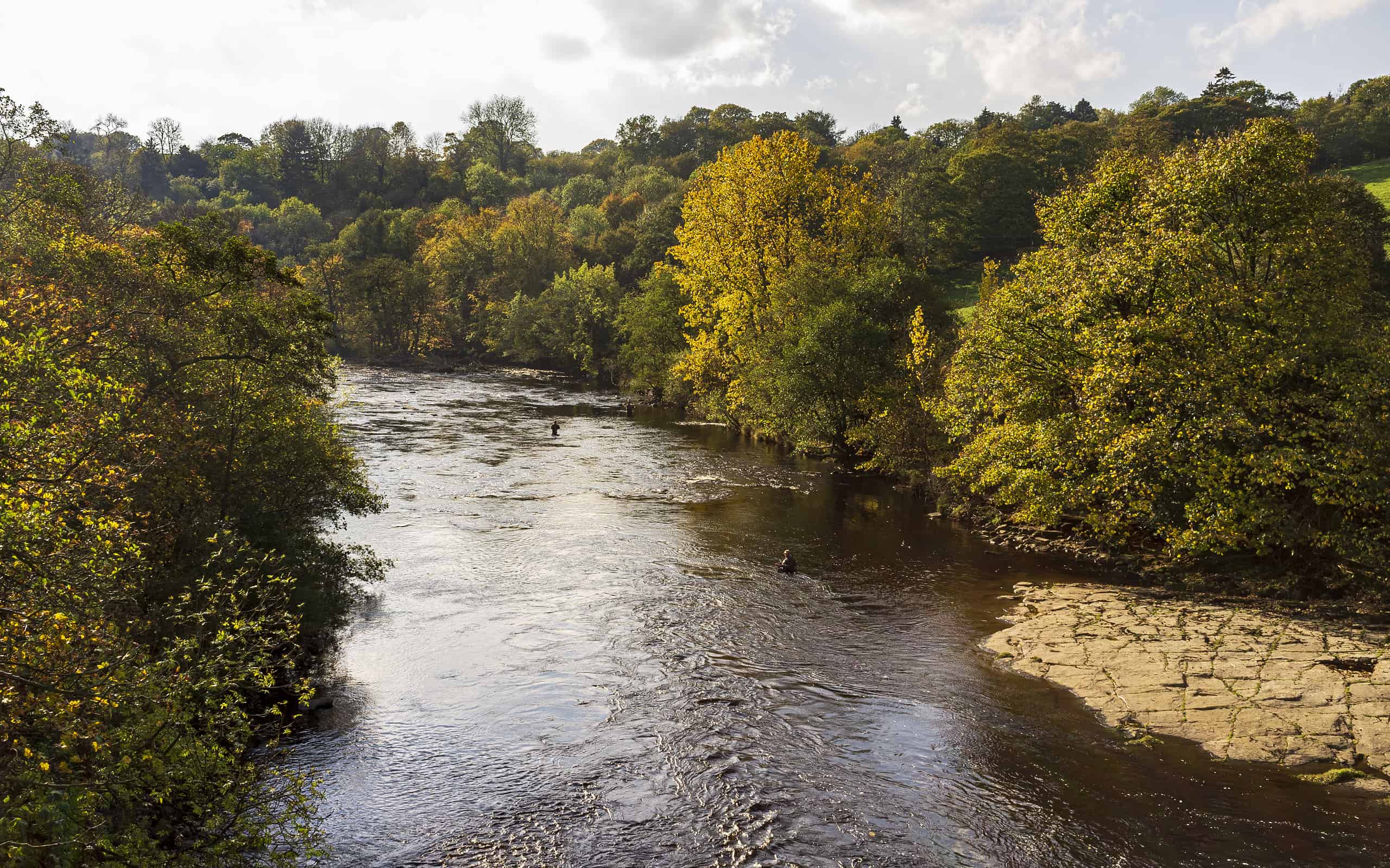
Fly fishermen in the River Swale near Richmond in North Yorkshire, England
©Glen_Pearson/iStock via Getty Images
Temperature: The River Swale in North Yorkshire can have temperatures as low as 4°C to 10°C (39°F to 50°F).
Ecological Significance: The Swale is a sanctuary for a variety of aquatic life. It is home to salmon, brown trout, grayling, and the critically endangered freshwater pearl mussel. The presence of these species is indicative of excellent water quality, therefore suggesting that the rivers waters are fresh and clean.
Recreational Activities: For adventurers who seek thrilling experiences, the Swale has white-water sections that are ideal for canoeing and kayaking. The river’s picturesque setting also attracts nature lovers, who can explore its scenic beauty on foot.
4. River Teme, Worcestershire

Dinham Bridge, the River Teme and Ludlow Castle ruins, Shropshire, England, UK
©travellinglight/iStock via Getty Images
Temperature: The River Teme in Worcestershire maintains chilly temperatures, ranging from 6°C to 11°C (43°F to 52°F).
Ecological Significance: Beyond its cold waters, the Teme is an important habitat for wildlife. It is home to otters, kingfishers, and various fish species, including barbel and chub. The presence of these species highlights the river’s ecological importance.
Recreational Activities: Anglers are drawn to the River Teme because of its diverse fish populations. It is a favorite spot for fishing enthusiasts who are looking to catch barbel, chub, and trout. The riverbanks also have tranquil settings for picnics, walks, and relaxation.
5. River Wye, Derbyshire

Cottages alongside the River Wye, Bakewell, Derbyshire, England, UK, Western Europe.
©CaronB/iStock via Getty Images
Temperature: The River Wye in Derbyshire features cold waters, with temperatures hovering between 5°C and 11°C (41°F to 52°F).
Ecological Significance: The Wye is famous for its diverse aquatic life. It supports huge populations of brown trout and grayling, which indicate high water quality of the river. Additionally, the Wye also creates a vital habitat for various invertebrate species.
Recreational Activities: The River Wye attracts a multitude of visitors, particularly those who are interested in fly fishing. Anglers flock to the river in pursuit of salmon, trout, and grayling. Adventurous folks can also explore the Wye’s scenic sections, which have opportunities for kayaking and wild swimming in some areas.
6. River Dove, Derbyshire

Dovedale in the Peak District of England. The land is owned by the National Trust and attracts a million visitors annually. The valley was cut by the River Dove and runs for just over 3 miles (5 km) between Milldale in the north and a wooded ravine, near Thorpe Cloud and Bunster Hill, in the south.
©Will Perrett/iStock via Getty Images
Temperature: The River Dove, nestled in the Peak District, has temperatures between 5°C and 10°C (41°F to 50°F).
Ecological Significance: Beyond its icy waters, the River Dove also has healthy populations of trout and grayling. This cold river is an essential part of the ecosystem because it supports various species of aquatic life.
Recreational Activities: The River Dove is a true haven for fly fishing enthusiasts, who come to test their skills against the challenging currents as well as the elusive trout. Additionally, the scenic surroundings have excellent opportunities for hiking and exploration in the picturesque Peak District.
7. River Derwent, Cumbria

Grange Bridge at the village of Grange over the River Derwent in the Lake District
©daverhead/iStock via Getty Images
Temperature: The River Derwent in Cumbria is known for its cold waters, with temperatures typically ranging between 5°C to 11°C (41°F to 52°F).
Ecological Significance: The Derwent is more than just a frigid river; it is home to significant salmon and sea trout runs, which suggest fresh waters. These species rely on the river for spawning, making it an essential aquatic ecosystem.
Recreational Activities: Anglers are drawn to the River Derwent for salmon and trout fishing, while the river’s surroundings are also great for hiking and birdwatching. Its serene beauty makes it an ideal location for enjoying the great outdoors.
8. River Wear, County Durham

Durham Cathedral and River Wear in Spring in Durham, United Kingdom
©palliki/iStock via Getty Images
Temperature: Flowing through County Durham, the River Wear’s temperatures range from 5°C to 11°C (41°F to 52°F).
Ecological Significance: River Wear is famous for its salmon and sea trout and is is a critical habitat for the critically endangered freshwater pearl mussel. The presence of these species highlights the river’s water quality and ecological value.
Recreational Activities: Anglers frequent the River Wear for salmon and trout fishing. It is also a popular destination for fly fishing. The river’s scenic surroundings also have opportunities for hiking and wildlife spotting, making it a serene escape for nature lovers.
9. River Tees, County Durham

View of the winding River Tees and the beautiful countryside in Teesdale in winter
©TraceyAPhotos/iStock via Getty Images
Temperature: The River Tees in County Durham maintains its cold waters and has temperatures typically between 5°C and 11°C (41°F to 52°F).
Ecological Significance: The Tees is known for its valuable salmon, trout, and grayling populations. These fish thrive in its chilly waters, making the river an essential part of the region’s ecology.
Recreational Activities: Fly fishers are drawn to the River Tees, where they can try their hand at catching salmon, trout, and grayling.
10. River Tyne, Northumberland

The Gateshead Millennium Bridge is a pedestrian and cyclist tilt bridge spanning the River Tyne in England between Gateshead’s Quays arts quarter on the south bank, and the Quayside of Newcastle upon Tyne on the north bank. image no 190.
©SAKhanPhotography/iStock via Getty Images
Temperature: Flowing through Northumberland, the River Tyne has temperatures ranging from 5°C to 11°C (41°F to 52°F).
Ecological Significance: The Tyne is a significant river for salmon and sea trout runs, which makes it ecologically important. Additionally, it also provides a habitat for various other aquatic species.
Recreational Activities: The River Tyne is a popular destination for anglers looking to catch salmon and trout. Fly fishing is also a popular activity here. The riverbanks and surrounding landscapes also provide opportunities for scenic walks and outdoor exploration.
Wildlife That Can Survive in Cold Rivers in England
The cold rivers of England are home to a fascinating array of wildlife specially adapted to thrive in these unique aquatic ecosystems. Despite the cold temperatures, these rivers support diverse and resilient species that have evolved to endure these freezing challenges. Here are some of the key wildlife species that can be found in England’s cold rivers:
Atlantic Salmon (Salmo salar)
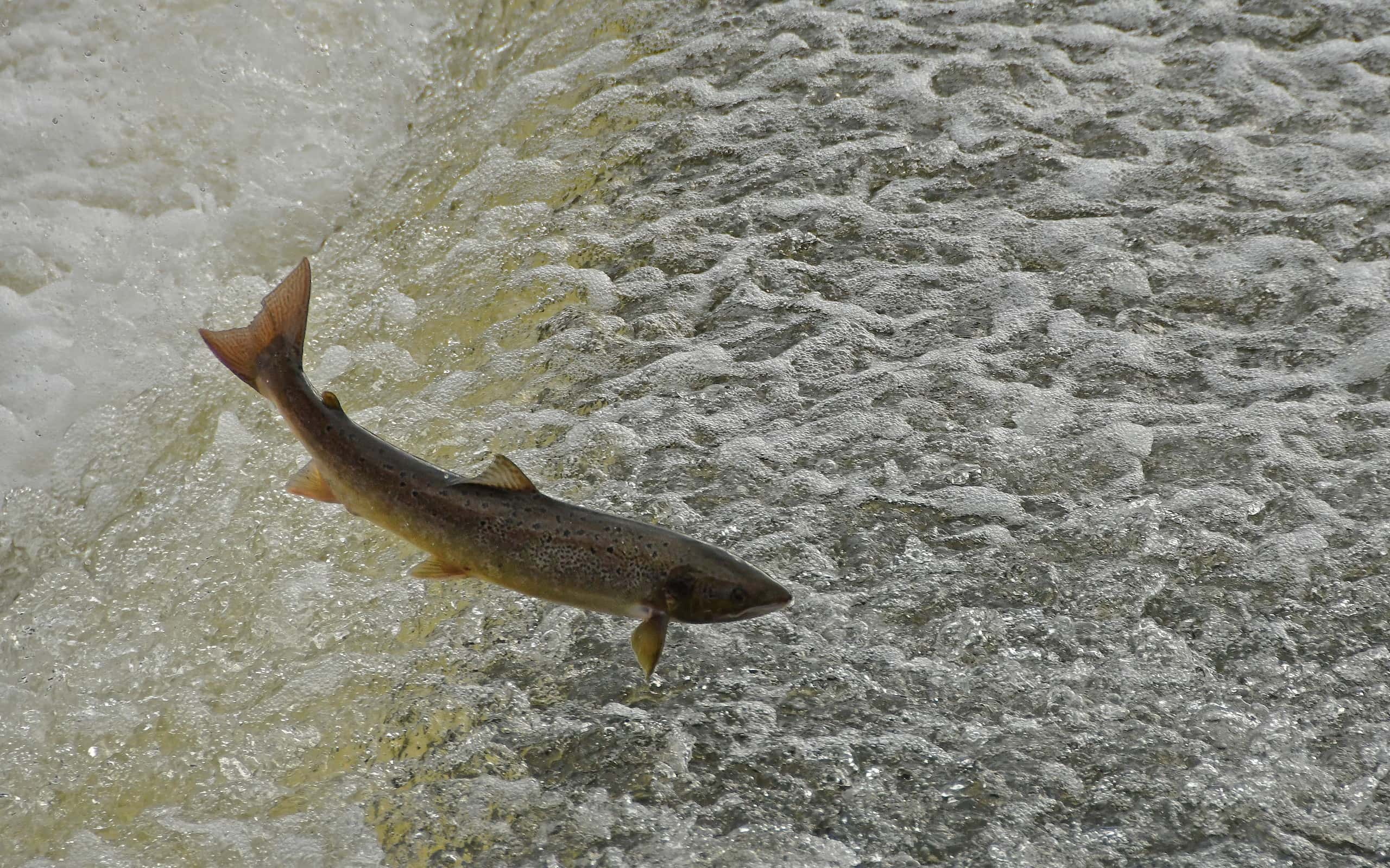
Atlantic salmon leaping weir on the River Severn, Shrewsbury, Shropshire, UK
©Connah/iStock via Getty Images
Iconic by nature, Atlantic salmon are inhabitants of cold rivers. They are known for their silver bodies and characteristic pink and red spawning colors. They are also economically significant for recreational fishing.
Salmon are anadromous, which means they migrate from saltwater to freshwater to spawn. They are often associated with fast-flowing, cold rivers, where they lay their eggs in gravel beds. This fish species is also a vital indicator of a river’s health. Their presence indicates good water quality and habitat conditions.
Brown Trout (Salmo trutta)
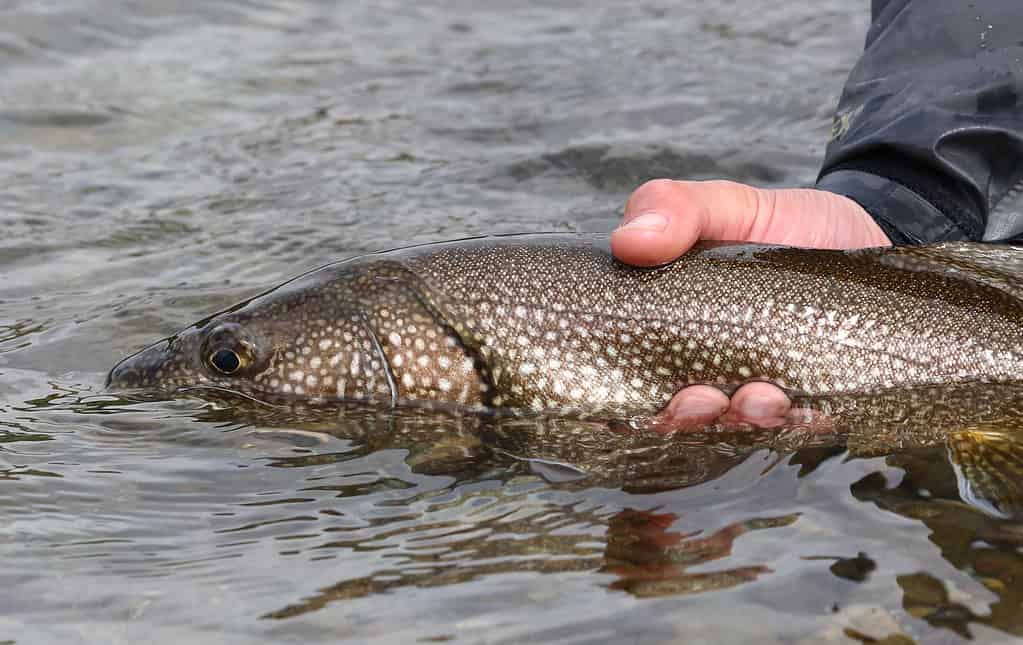
Lake trout are usually brown or olive-gray and feature yellowish or white spots; their underparts are typically white.
©Iryna Harry/Shutterstock.com
Brown trout are brownish-green in color with black spots on their sides. They are a species of freshwater fish.They are adaptable and can thrive in a variety of coldwater environments, including rivers and streams. They prefer clear, cold water with abundant food sources.
However, brown trout are a popular target for anglers. Anglers should be careful to not catch too many since these fish play a crucial role in aquatic food chains, feeding on aquatic insects and providing food for larger predators.
Grayling (Thymallus thymallus)
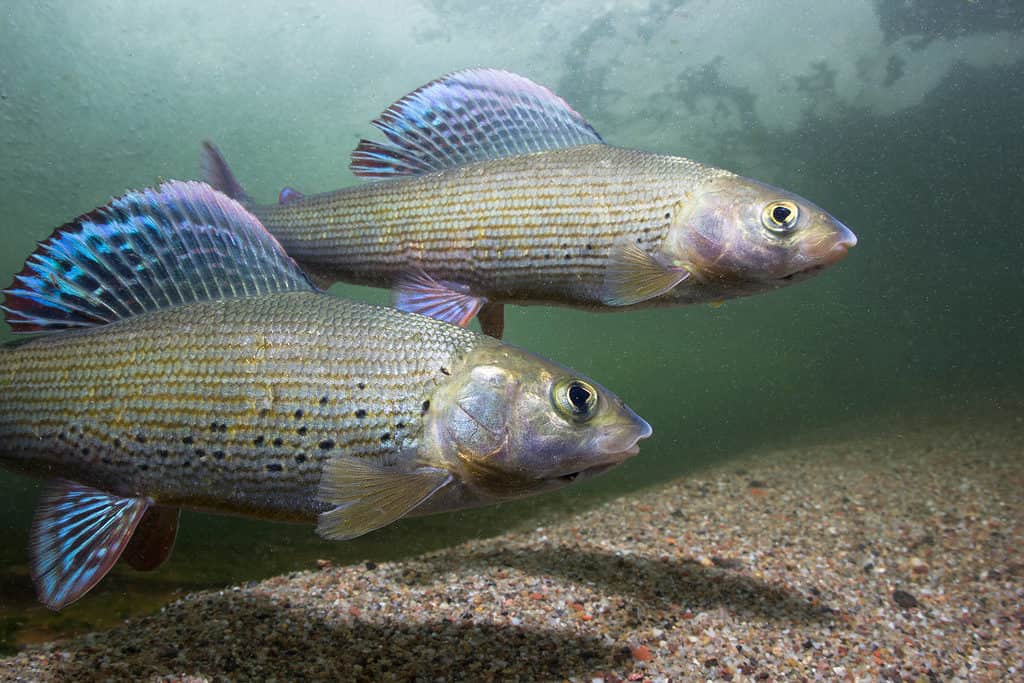
Graylings have a spectacular fanned dorsal fin that reflects the light, shimmering in a multitude of colors.
©Rostislav Stefanek/Shutterstock.com
These fish called graylings are easily recognizable by their sail-like dorsal fin. They have a silvery-gray body with a slightly forked tail. These are cold-water fish that prefer clear and moderately fast-flowing rivers. They are often found in well-oxygenated waters with gravel or sandy bottoms.
Grayling are an indicator species of good water quality. They are also sought after by anglers, particularly fly fishermen.
Freshwater Pearl Mussel (Margaritifera margaritifera)
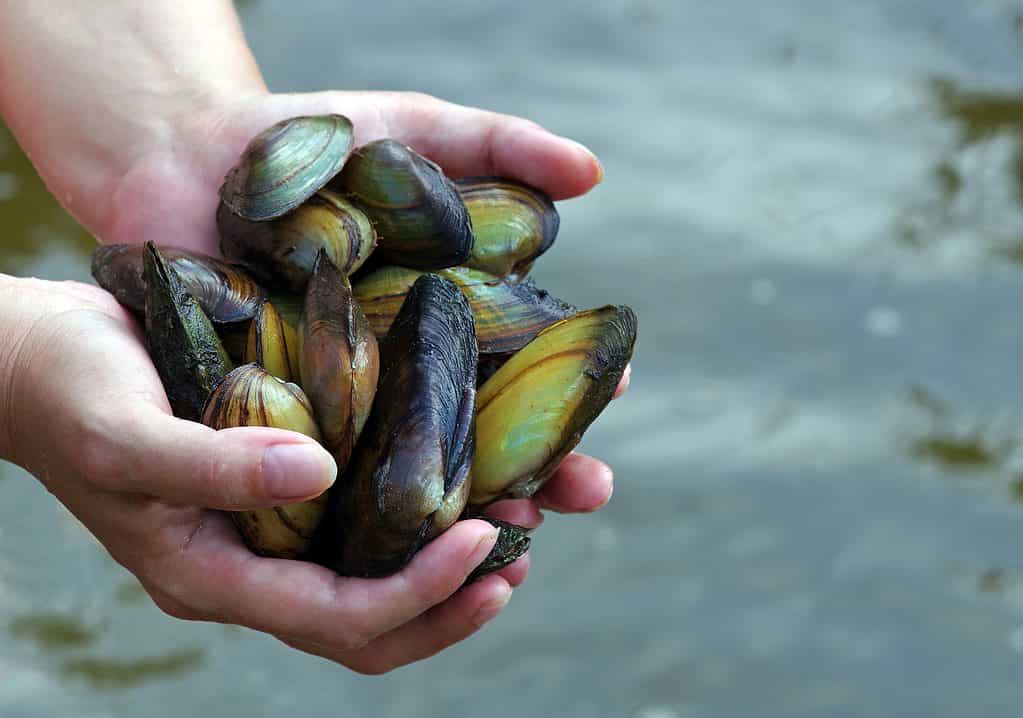
They might not be the most photogenic creature on our list, but freshwater pearl mussels are nonetheless important.
©KRIACHKO OLEKSII/Shutterstock.com
Freshwater pearl mussels are mollusks that have a dark, elongated shell. They are known for producing pearls. These mussels inhabit the clean, cold and well-oxygenated waters of rivers and streams. They prefer stable gravel or sandy riverbeds.
However, freshwater pearl mussels are critically endangered and are protected in many areas. Their presence is an indicator of excellent water quality, as they are sensitive to pollution.
Dippers (Cinclus cinclus)

Birds called dippers are well suited to cold environments, especially cold rivers.
©ShayneKayePhoto/Shutterstock.com
Dippers are small, plump birds with dark brown plumage and a distinctive bobbing motion when perched on rocks in rivers. They are well adapted to cold river environments. They forage for aquatic insects and invertebrates underwater and build their nests near riverbanks.
Like other animals on this list, they are indicators of clean, unpolluted rivers. They are also fascinating to observe as they dive and swim underwater to find food.
Kingfishers (Alcedo atthis)
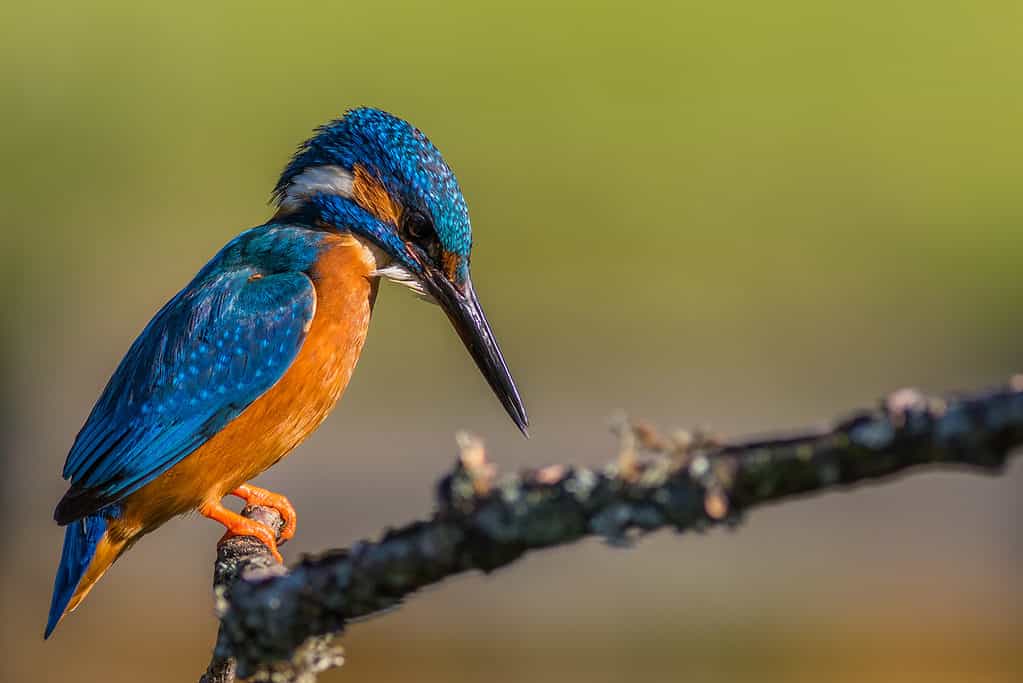
kingfisher (Alcedo atthis) perched on a branch
©iStock.com/chris2766
Kingfishers are colorful birds with bright blue and orange plumage. They are known for their remarkable fishing skills and are often found along rivers and streams, where they hunt for fish, insects, and crustaceans. They nest in burrows along riverbanks.
Kingfishers are not only a symbol of healthy rivers but also a delight for birdwatchers due to their vibrant colors and distinctive calls.
Water Voles (Arvicola amphibius)

Water Vole on river bank
©suerob/iStock via Getty Images
These small, furry mammals called water voles have a rounded body and a blunt nose. They are often mistaken for rats but have a more rounded face and shorter tail. Water voles inhabit riverbanks, where they create burrows and tunnels. They are excellent swimmers and forage for vegetation along the river’s edge.
Water voles are an important part of riverbank ecosystems. They are, however, a threatened species and thus a focus of conservation efforts.
Other Trout and Salmon Parr

Steelhead salmon are silver and grey with dark blue back or pink and orange specks
©Sean Lema/Shutterstock.com
Young salmon and trout, known as parr, have distinct markings and coloration. They are smaller versions of their adult counterparts. Parr spend their early stages in the cold, clear waters of rivers, where they find shelter among rocks and gravel beds.
Since parr are the future generations of salmon and trout, it makes them vital to the overall health of these fish populations.
Thus, these rivers while being challenging environments are essential for many species. Their health reflects the overall ecological well-being of the region. But these freshwater environments are also threatened due to their delicate nature. Therefore, conservation efforts and responsible management are crucial to ensure the survival of these unique and valuable species.
Final Thoughts
These ten coldest rivers in England provide a glimpse into the country’s diverse natural landscapes and wildlife. But they are also great spots for more recreational activities. From angling to kayaking, from wildlife observation to peaceful walks along their banks, these rivers invite people to explore the unique English countryside.
The photo featured at the top of this post is © Ian Luck/Shutterstock.com
Thank you for reading! Have some feedback for us? Contact the AZ Animals editorial team.







